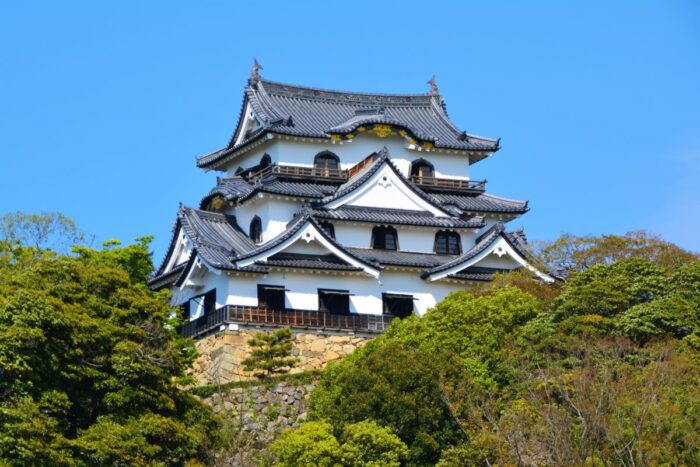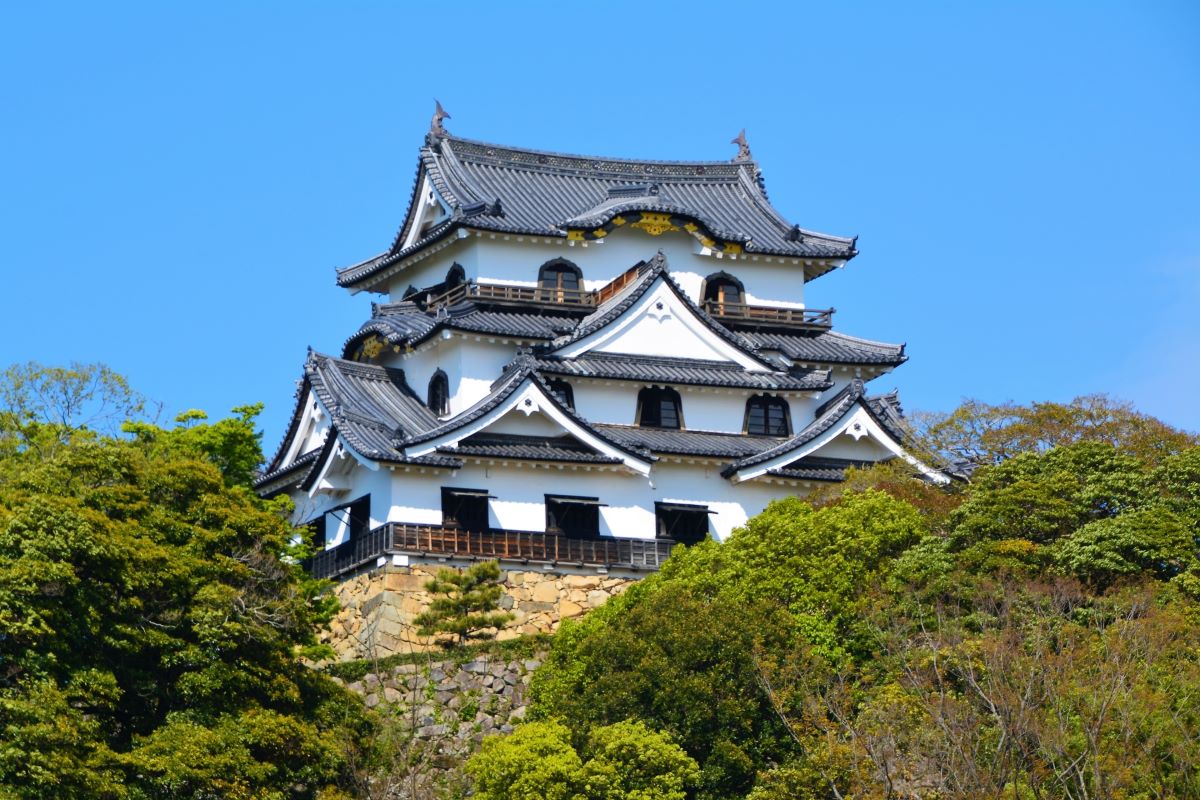Hikone Castle, constructed in the early 17th century, is a historical gem in Japan. Strategically located on the Nakasendo highway, it was built by daimyo Ii Naomasa to serve as the seat of the Ii clan.

With its unique hilltop design and concentric moats, Hikone Castle blends medieval defensive structures with early modern architecture. Designated as a National Historic Site and Special Historic Site, this castle is a must-visit for castle enthusiasts, samurai culture lovers, and those fascinated by architecture.

Come explore the grounds and delve into the rich history of Hikone Castle.
Key Takeaways
- Hikone Castle was constructed in the early 17th century by daimyo Ii Naomasa and is located on the Nakasendo highway.
- The castle utilizes a unique hilltop design on Mt. Konki, with an inner complex atop the summit surrounded by concentric moats.
- The main keep of Hikone Castle is designated as a National Treasure and is one of only five castles in Japan with an original main keep.
- Hikone Castle is almost entirely preserved in its original completed form from 1622 and is designated as a National Historic Site and Special Historic Site.
Historical Significance

Hikone Castle holds immense historical significance as one of the few castles in Japan that has remained almost entirely in its original completed form since 1622. Situated on a hilltop in Hikone City, Shiga Prefecture, this feudal era treasure offers a glimpse into Japan’s rich history.
Originally built by daimyo Ii Naomasa, Hikone Castle served as the seat of the powerful Ii clan. Its strategic location on the Nakasendo highway made it an important stronghold. The castle’s design is a blend of medieval defensive structures and early modern architecture, with its main keep standing three stories high.
Visitors can explore the entire grounds, including the impressive double moats, gates, and turrets. Hikone Castle Museum, located within the castle grounds, features rebuilt sections of the former palace.
Whether you are interested in castles, samurai culture, or architecture, Hikone Castle is a must-visit destination.
Unique Design and Architecture
Perched atop Mt. Konki, the historic fortress showcases a distinctive hilltop design and a network of concentric moats. The unique design and architecture of Hikone Castle are a testament to the ingenuity and craftsmanship of the daimyo Ii Naomasa and his clan.
Here are five key features that make Hikone Castle a truly remarkable structure:
- Utilizes a unique hilltop design on Mt. Konki, providing a commanding view of the surrounding area.
- The inner complex, situated atop the summit, is surrounded by concentric moats, enhancing its defensive capabilities.
- The main keep stands three stories high, serving as the focal point of the castle’s architectural grandeur.
- Elements of Hikone Castle were recycled from nearby castles, giving it a blend of medieval defensive structures and early modern architecture.
- The castle’s preservation and restoration efforts ensure that its cultural and architectural integrity is protected, making it a must-visit for those interested in castles, samurai culture, or architecture.
Hikone Castle is a true treasure of the Japanese feudal era, offering visitors a glimpse into the rich history and architectural brilliance of the time.
Notable Structures

Located atop Mt. Konki, Hikone Castle boasts several notable structures that showcase the architectural brilliance of the time.
Among them is the Main Keep, one of only five castles in Japan with its original main keep designated as a National Treasure. Standing three stories high, it offers a glimpse into the grandeur and power of the samurai lords who once resided there.
Another impressive structure is the Tenbin Yagura, a gate adorned with twin two-story turrets that served as a defensive stronghold.
The Taikomon Gate, the former main entrance to the innermost section of the castle, is also worth noting for its imposing presence.
Hikone Castle’s perfectly preserved double moats and the serene Genkyuen Garden, with its beautiful lake views, further add to the allure of this feudal era treasure.
For those seeking freedom and a deeper understanding of Japan’s rich history, a visit to Hikone Castle is a must.
Preservation and Restoration Efforts
Preservationists have made significant efforts to ensure that Hikone Castle remains in its original form, with ongoing restoration and reconstruction projects to protect its cultural and architectural integrity. These efforts are vital in maintaining the historical significance of the castle and allowing visitors to experience the grandeur of the Japanese feudal era.
The castle, designated as a National Historic Site and Special Historic Site, requires the highest level of preservation. Currently, restoration work is being carried out to keep the castle in its original completed form from 1622. The dedication of the preservationists ensures that future generations can appreciate the unique hilltop design, the main keep, the beautifully preserved moats, and other key structures of the castle.
Visiting Hikone Castle is a must for those who want to enjoy the rich history of Japan and witness the architectural marvels of the past.
Exploring the Castle Grounds
Visitors can embark on walking tours to explore the vast grounds of Hikone Castle. Here, they can marvel at the moats, turrets, gates, and main keep, immersing themselves in the rich history and architectural wonders of this ancient site.
As they wander through the castle grounds, they will be transported back in time to the Japanese feudal era. The castle’s unique hilltop design on Mt. Konki offers breathtaking views and a sense of grandeur. The inner complex, surrounded by concentric moats, showcases the strategic defensive structures of the time.
The main keep, standing three stories high, is a National Treasure and a rare sight to behold. And for those seeking tranquility, the Genkyuen Garden offers a scenic escape with its beautiful lake views.
With its preserved structures, Hikone Castle provides an authentic experience for history enthusiasts, castle lovers, and anyone seeking a glimpse into Japan’s rich heritage.
Seasonal Beauty: Cherry Blossoms and Autumn Leaves
Cherry blossoms in spring and vibrant autumn foliage add a touch of natural beauty to the already captivating grounds of Hikone Castle. This feudal era treasure, located in Hikone, Japan, is a must-visit for those who appreciate the freedom of exploring historical sites. Here are five reasons why the seasonal beauty of Hikone Castle is a sight to behold:
- Cherry Blossoms: Delicate pink petals blanket the castle grounds, creating a picturesque scene that symbolizes renewal and the transient nature of life.
- Autumn Leaves: The vibrant hues of red, orange, and gold paint the landscape, transforming Hikone Castle into a breathtaking masterpiece during the fall season.
- Serene Lake Views: The Genkyuen Garden, located within the castle grounds, offers stunning lake views that perfectly complement the seasonal beauty.
- Historical Significance: The castle’s history dates back to the early 17th century, making it a living testament to Japan’s feudal past and samurai culture.
- Architectural Marvel: The blend of medieval defensive structures and early modern architecture showcases the ingenuity and craftsmanship of the time.
Immerse yourself in the freedom of nature’s artistry and discover the timeless beauty of Hikone Castle.
A Must-Visit for Castle Enthusiasts and History Lovers
History enthusiasts and those fascinated by medieval architecture will find Hikone Castle to be an essential destination due to its rich historical significance and architectural marvels. Constructed in the early 17th century by daimyo Ii Naomasa, the castle served as the seat of the Ii clan daimyo.
Located strategically on the Nakasendo highway, Hikone Castle boasts a unique hilltop design on Mt. Konki. Its inner complex, atop the summit, is surrounded by concentric moats, while the main keep stands three stories high. The castle is one of five in Japan with an original main keep designated as a National Treasure.
Visitors can explore the entire grounds, including the moats, turrets, gates, and main keep, and learn about the castle’s history at the Hikone Castle Museum. With its cultural and architectural integrity protected, Hikone Castle is a must-visit for those interested in castles, samurai culture, or architecture.
Frequently Asked Questions
Are There Any Legends or Folklore Associated With Hikone Castle?
Yes, there are several legends and folklore associated with Hikone Castle. These stories include tales of samurai ghosts, hidden treasure, and a magical stone that grants wishes. Visitors can learn more about these fascinating legends during their visit.
How Long Did It Take to Construct Hikone Castle?
It took several years to construct Hikone Castle. The castle was completed in 1622 and became the seat of the Ii clan daimyo. Its unique hilltop design and blend of medieval and modern architecture make it a fascinating historical treasure.
What Is the Significance of the Name “Hikone”?
The name ‘Hikone’ holds significance in relation to Hikone Castle. It represents the city where the castle is located and is derived from the nearby lake, Lake Biwa.
How Did the Castle Play a Role in the Battle of Sekigahara?
Hikone Castle played a role in the Battle of Sekigahara when daimyo Ii Naomasa was granted control of the Hikone Domain. Its strategic location on the Nakasendo highway made it an important stronghold.
Are There Any Famous Samurai or Historical Figures Associated With Hikone Castle?
There are indeed famous samurai and historical figures associated with Hikone Castle. It was the seat of the Ii clan daimyo, including Ii Naomasa, who played a role in the Battle of Sekigahara.
The Sum Up
To sum it up, Hikone Castle is a true treasure of Japan’s feudal era. Its historical significance, unique design, and well-preserved structures make it a must-visit for anyone interested in samurai culture and architecture.
The castle’s strategic location on the Nakasendo highway and its blend of medieval defensive structures with early modern architecture make it a fascinating sight to behold.
With its designation as a National Treasure and National Historic Site, Hikone Castle stands as a testament to Japan’s rich history and is a captivating destination for history lovers and castle enthusiasts alike.




